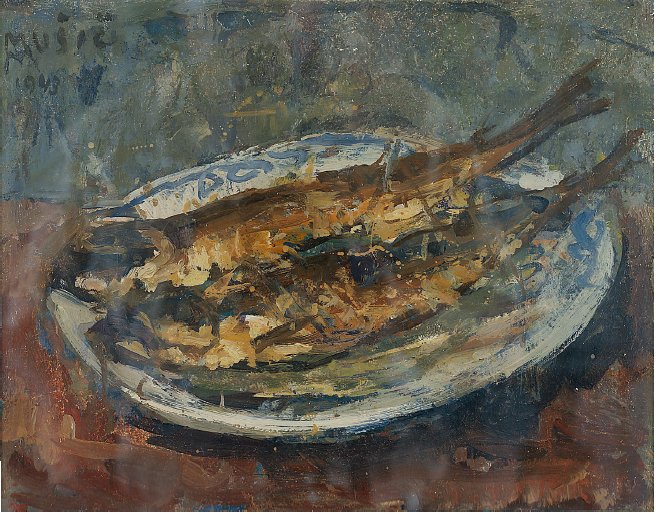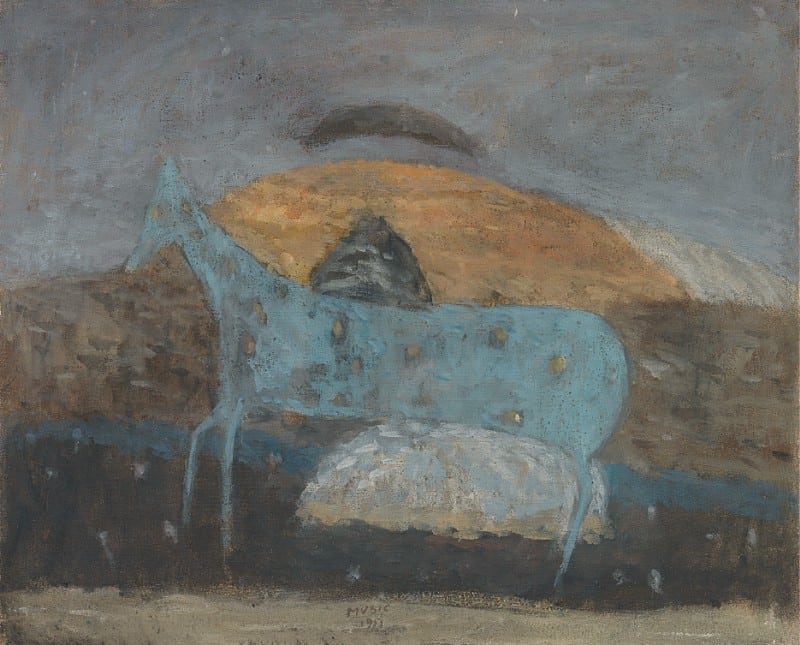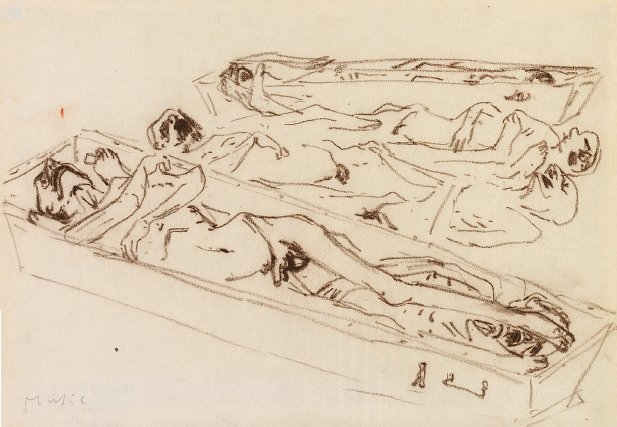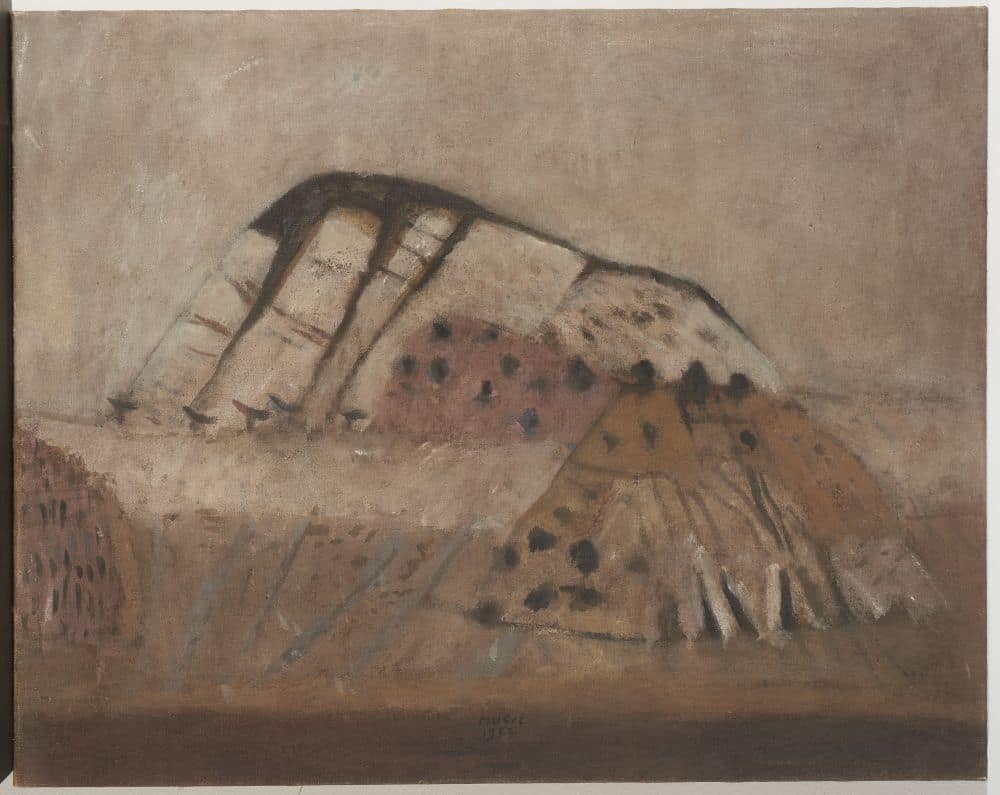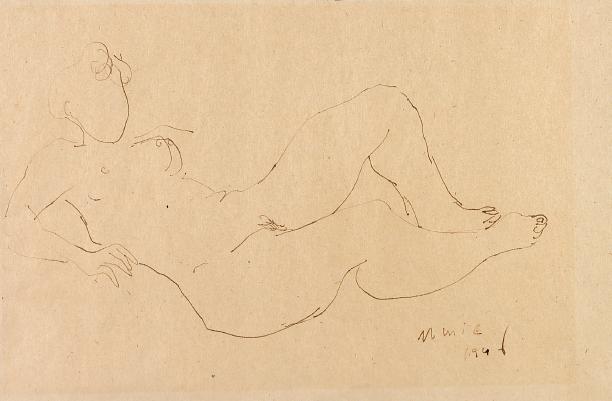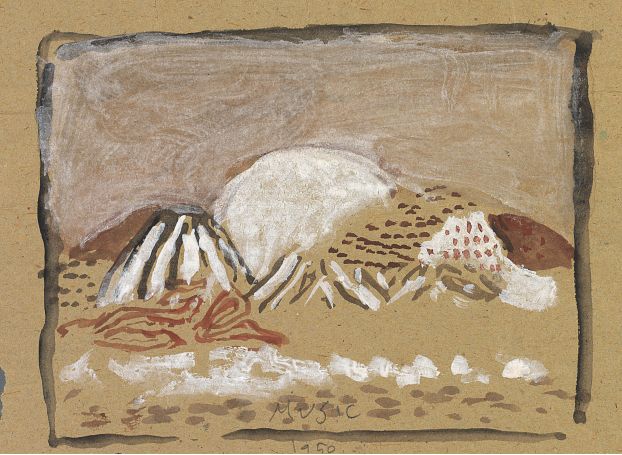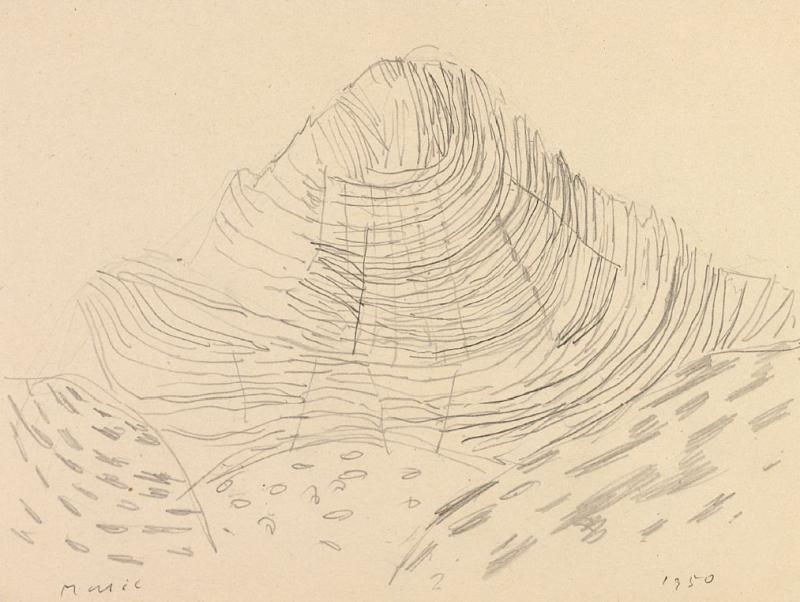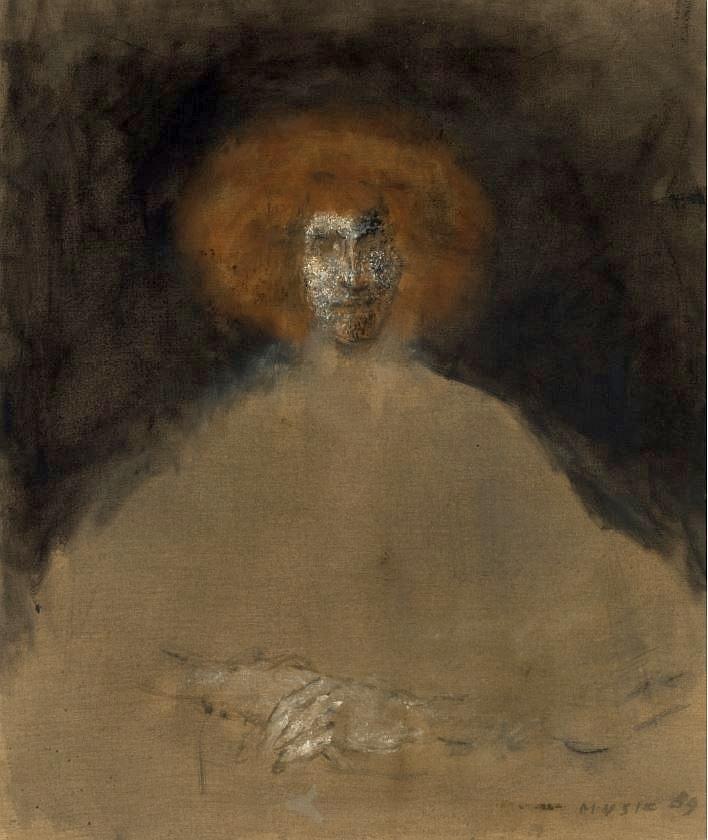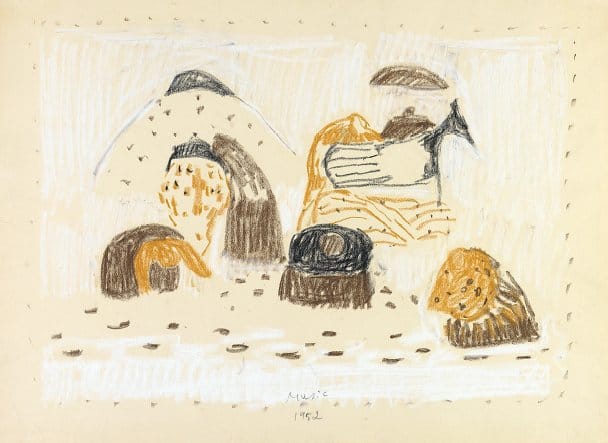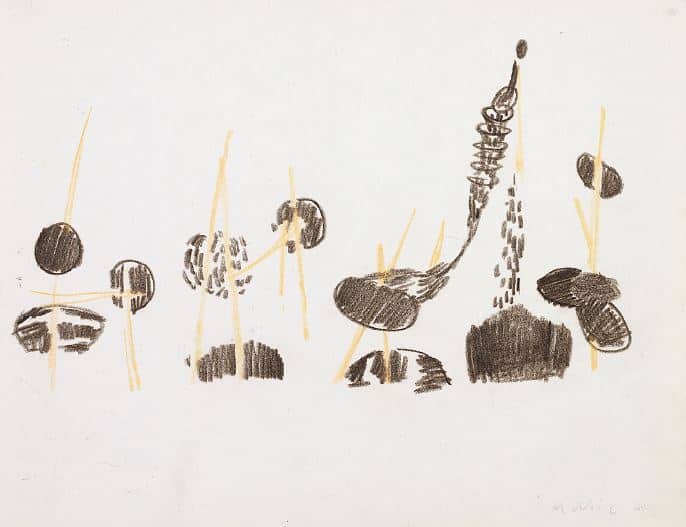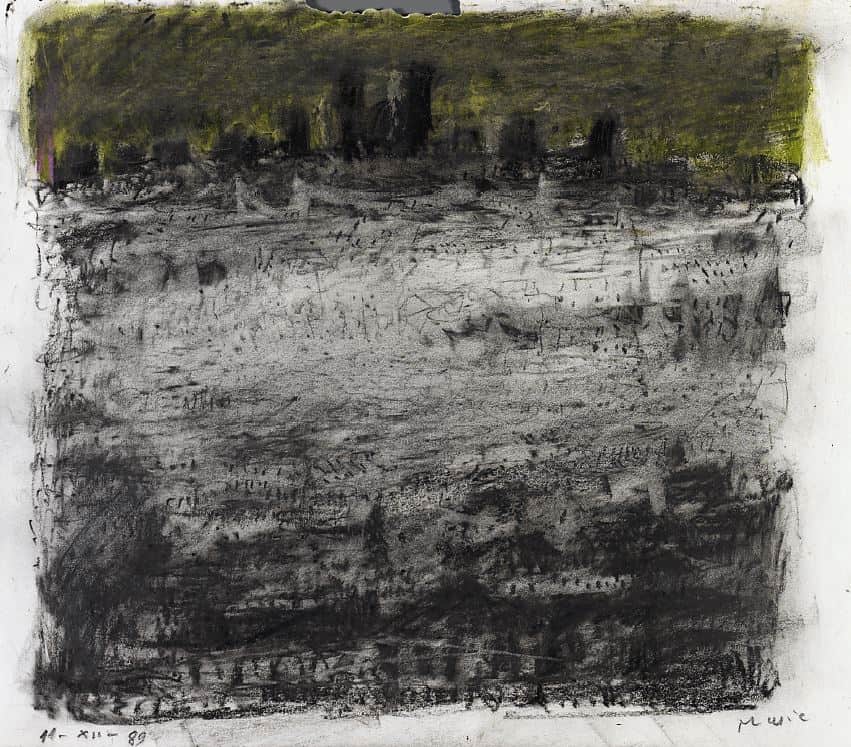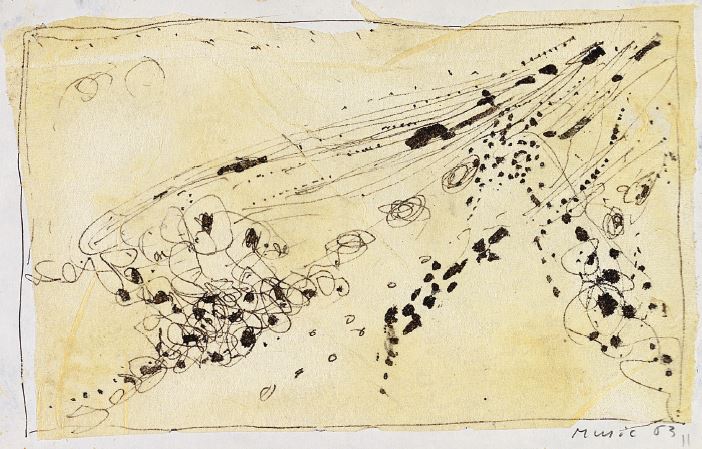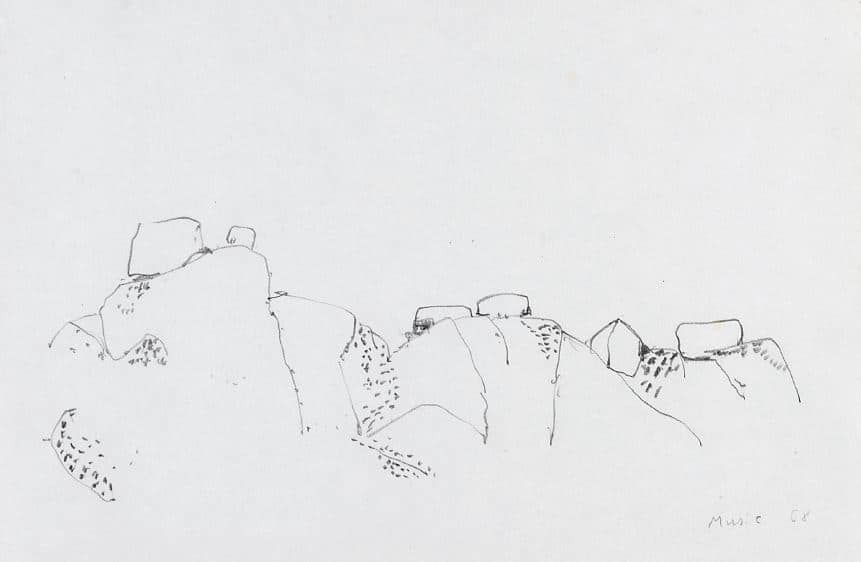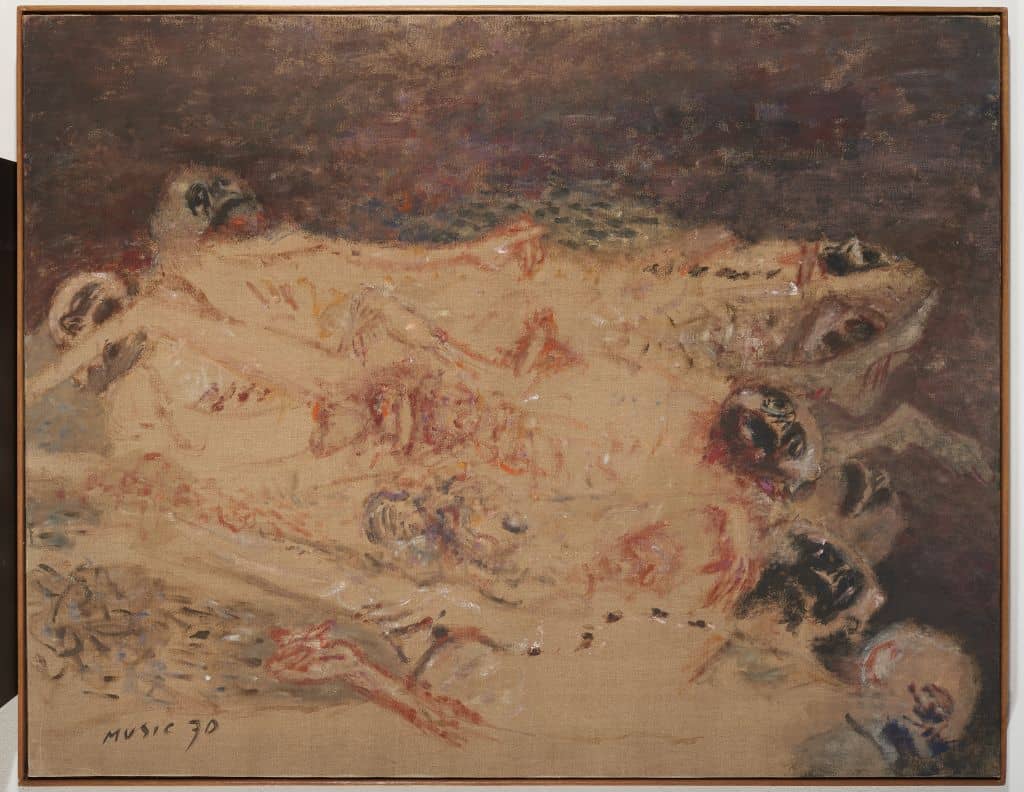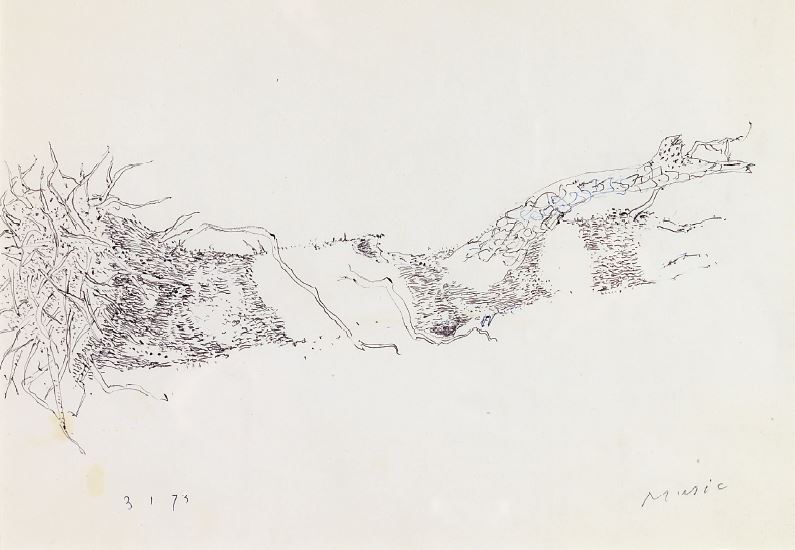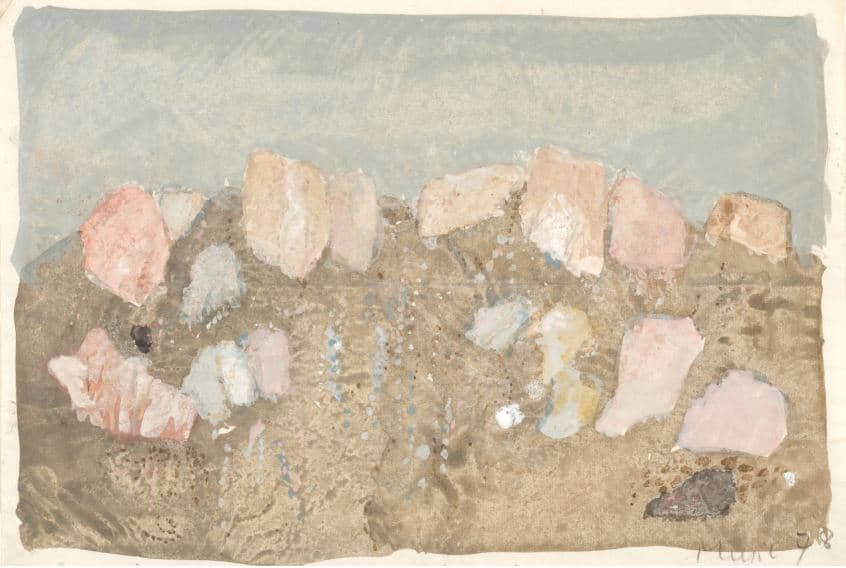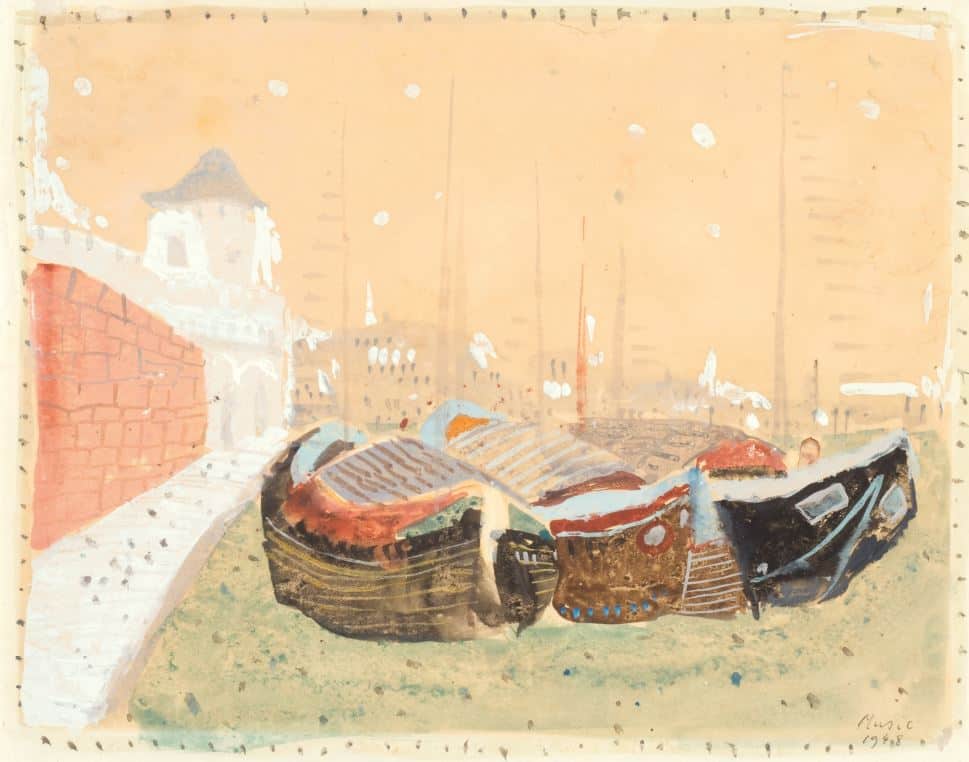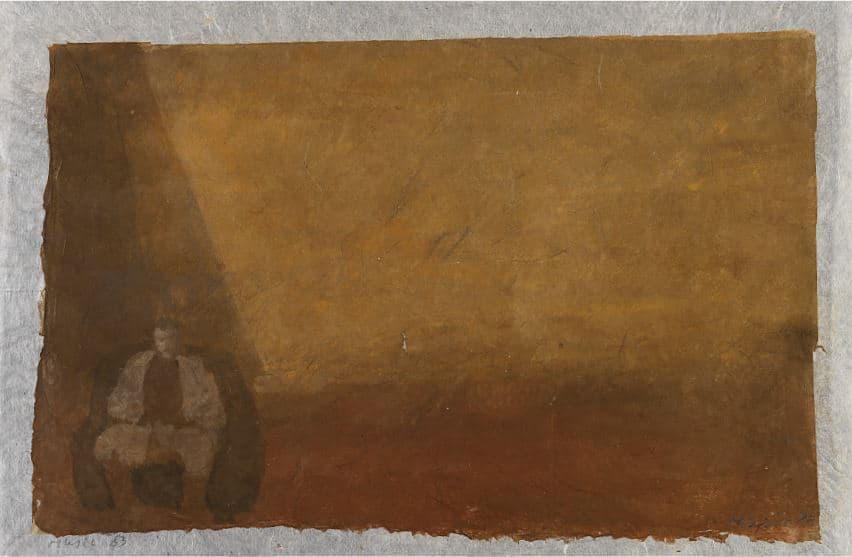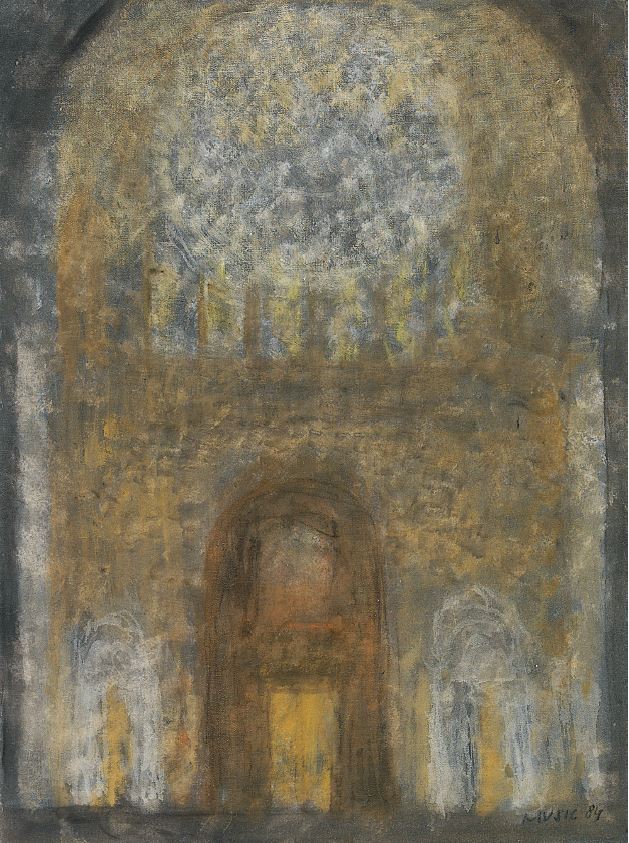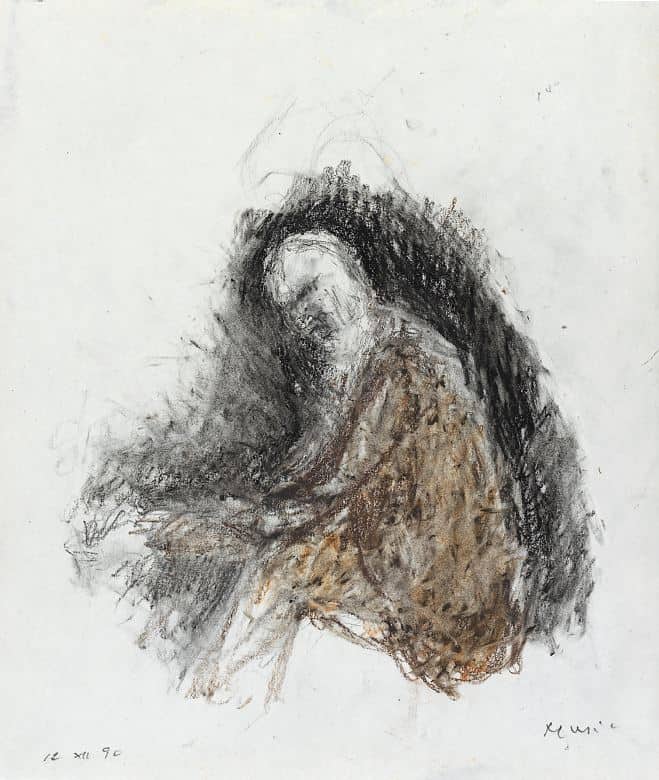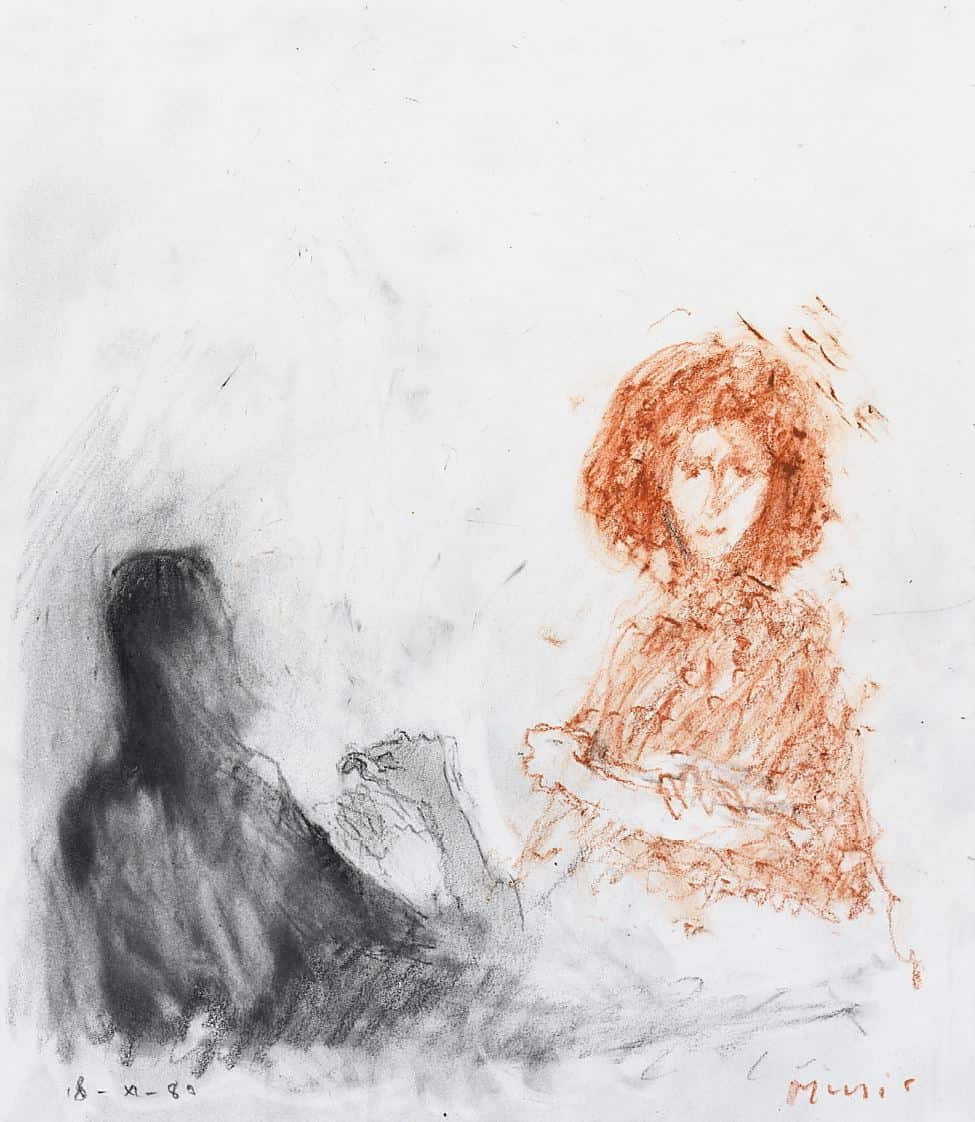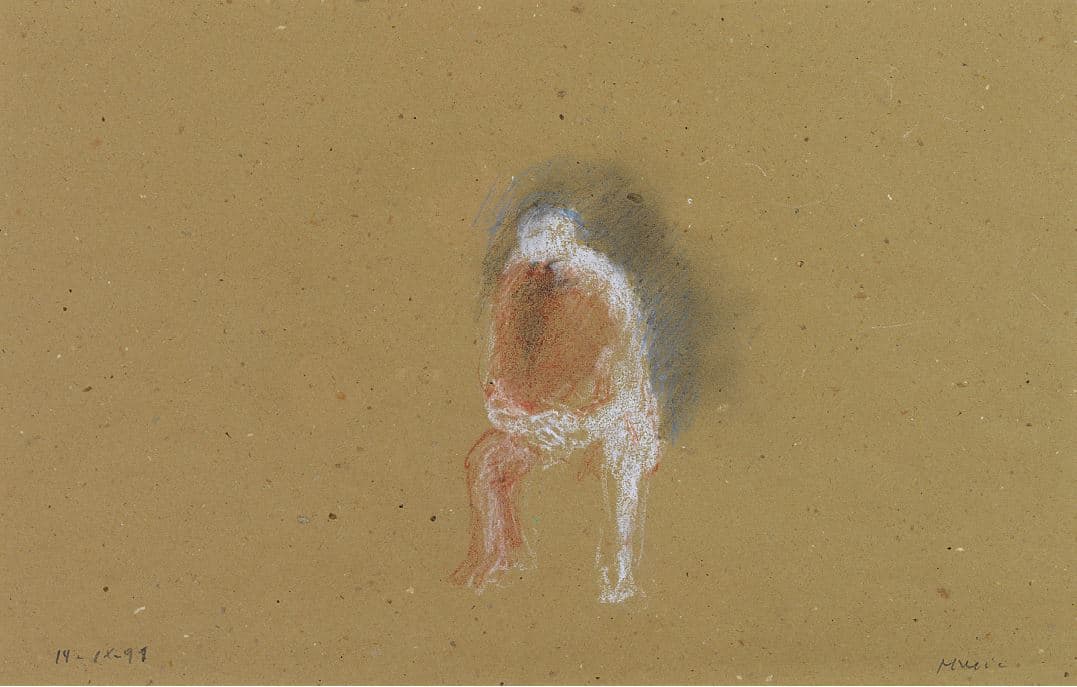Odkrijte Music Zbirke Slik
Spletne strani te knjige so napisane v angleščini.
450 barvnih plošč in 600 ilustracij
Največja zbirka del Zoran Music iz zbrane knjige Siegbert Metelko.
656 strani
V tej visokokakovostni zbirki Siegbert Metelko in Charlotte Hug iz leta 2009 začnete čudovito ustvarjalno potovanje skozi umetniška dela Zoran Music.
Na 656 straneh najdete približno 450 barvnih plošč in več kot 600 ilustracij v najvišji kakovosti. Besedila v knjigi so objavljena v treh jezikih: nemščina, angleščina in Francais. Knjiga tehta 5,2 kg.
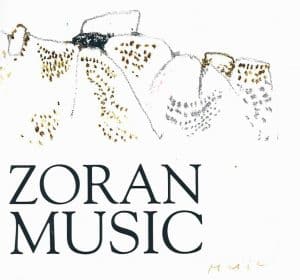
Z delom zbirajte številne umetnine Zoran Music domov!
Last look at Zoran Music, which I was allowed to accompany for more than 25 years soon up close, now from afar: The Vaporetto goes under the Ponte dell’Accademia, towards San Marco. On the curved balcony of the Palazzo Balbi-Valier, the tall figure of the old gentleman, the evening breeze blows a strand of hair into his face. But it would not help to make a sign in front of him. Zoran Music is almost blind. Nevertheless, he now seems to fix something infinitely distant, as if he absolutely wanted to fathom this something.
What is behind the veil that the cat has drawn in front of his scrutinizing eyes? What have the eyes of the dead people stacked in Dachau in the snow still captured, whose gaze Zoran Music has never forgotten? Why did the friend Francois Mitterrand go to Egypt, the cataract hotel, shortly before his death? What did he want to see? Did he see it? Did he tell Zoran Music?
Most recently, Zoran Music’s gaze had narrowed, a tunnel vision with a vague idea of light at the end of the tube, as in the picture of Hieronymus Bosch at the Museo Civico Correr in Piazza San Marco. Zoran Music relies on the previously seen: Dachau’s dead mountains, the tormented people who told him to tell the living: “Non siamo gli ultimi.” The dry karst slopes of Dalmatia with their
Little horse and donkey. The red facades of Venice, the morning mist over the barges puffing against the Zattere; daily walk, from his apartment. And, again and again, lifelong fascination and obsession, the face of the beloved, the mysterious Venetian woman with the chestnut-colored mane: Ida. Much more shadowy the memory of your own reflection. Over the years, it became an icon, not its ego, but the unnameable behind every self.
And Jacques Lassaigne, director of the Musée de l’Art Moderne de la Ville de Paris, said in the same year:
Music’s work is not an outcry of rebellion, she raises no charges. Rather, it is a meditation of what he has experienced in the concentration camps. He himself has crossed all circles of hell. But today the most awful subjects under his hand preserve a kind of discretion, a kind of purity. The picture speaks by itself without ever becoming theatrical or literary. Goya contented himself with writing some of his etchings: “I saw that.” Music reveals the pain, it releases it, so to speak. Through the magical act of painting, the tragic figures he conjures transform into strange blossoms. Delicate shadows gather in the protruding bones of the face, in the eye sockets and in the mouths. Death, no longer viewed from the outside, but in this intimacy, receives a disturbing attraction. In their decay the emaciated human bodies take on enormous dimensions: phenomena that speak a direct language. Over deep black tones plays a palette of color nuances, soft pink, gray and ocher. A testimony that art is life.
But how can a person live with these memories, even if he captures them year after year? Over the course of our friendship, I once again had an opportunity to talk to Zoran Music about his existential mystery.
To this day I feel that the eyes of the dying follow me. They’ve never left me alone since: I still see them, the hundreds of glances that pleaded with me for help, which probably also accused me of climbing over their bodies in the ghostly landscape of the concentration camp, paving my way. Shiny eyes, who silently asked for the help of those few who were still able to walk. When evening came, the dying and the others, who were thought to be dead, were stacked like logs. It looked like a pyre, almost a kind of tower. A spooky tower: it seemed to me that it trembled and creaked. But these noises, they were perhaps nothing but the last moaning of the dying. Then it started to snow a little at night, it was March; and the next morning the tower stopped moving.
It was an absurd, unreal world in which one lived in a concentration camp. The rules were alien, but there was a meticulous order; she was cruel, cruel beyond the limits of the thinkable. Anyone who had the slightest power was allowed to crush you like a worm. But strange: we accepted this reality as if there were no other possible order. In the end, they doubted whether there was any outside world beyond the barbed wire.
Wait, apathy. I lived in a landscape of the dead and the dying. Nothing but corpses. A gruesome picture haunts me: It was noon. A living skeleton of inmate held his bowl firmly in his hands. He was looking for a quiet corner where he could sip his soup. It was not nutritious, but at least warm. He sat down on a vacant seat. It was the head of a dead man…
Zoran Music was always aloof, perhaps especially to his friends; and it was never easy to deal with him. He appreciated it when he respected him, and with it a stately Central European way of life which he, as the last of them, still embodied. One must never forget that he was a lord; the species is almost extinct.
He tolerated it, not without subtle irony, when one, clad in jeans, slid on his knees on the floor of his Parisian studio or Venetian retreat, under the veranda overlooking the lagoon, looking for leaves. He accepted it as a homage owed to him. Gracious as a king by the grace of God and smiling. It was simple and exquisite things that gave him pleasure. In this sense, he may have been one of the last dandies on the continent, in the spirit of Baudelaire. A dinner with members of the oldest Venetian families in the red-papered restaurant on the corner of the Quai Voltaire with the Rue du Bac, under the Atasier Idas. And with Ida as the queen of the evening. A trip to the Carinthian Griffen, where he spent two years of his childhood. The house, where he had lived with parents and siblings, should be demolished. As if it belonged to him, he climbed majestically up the stairs, opened the door to his room and inspected it, not without his indefinable smile. The factual statement followed: Here was my bed. The fireplace is still there. Then we went to the Slovenian nunneries in Völkermarkt; he had gone to school in her convent. He insisted on staying here. Now he came as Grandseigneur. With serious irony, this never left him, he let himself be served by the venerable sisters coffee. On the way home a sunflower field. He stopped, got out, and smiled imperceptibly. He had recovered the lost time.
Zoran Music was a person of Central Europe. Central Europe, that is that almost unknown continent in the continent, the inserted in the larger whole is like a Russian doll. Central Europeans, all Central Europeans, Slovenians, Hungarians, Czechs, Slovaks, Austrians, Croats, Poles, and and, consider themselves and their geographically never definable homes to be the “Heart of Europe”. And because they are skeptics and probably also hypochondriacs, they look at this heart with suspicion. With a historically justified suspicion. Karl Kraus (speaking of old Austria) characterized the area as a laboratory for world declines.
To give an idea of the mythical-historical term Central Europe, let’s take a look at the city Gorizia / Gorizia / Gorica, where Zoran Music was born. It is a city neither ethnically nor historically definable: Metropolis once a county, to which both the blessed Collio belonged, and the valleys of today’s East Tyrol.
Görz bordered on the Republic of Venice, was culturally intimate with the lagoon city, but politically hostile. On the one hand the House of Austria, heir of the counts of Gorizia, on the other the Venetians in their star-shaped fortress Palmanova. You met your eyes and you mistrusted each other; suspicious and yet dependent on each other: by the mixed Italian-Friulan-Slavic population, by Catholic traditions, not least by the food: Mare è Montagna. Wild mushrooms and seafood, polenta, black wine.
Central Europe, then. Heart, stomach, but also neuralgic point of the continent. Zoran Music’s biography seems to me like a concentrate of the history of the “Continent in the Continent”. When he was born on February 12, 1909, Görz, an at least trilingual city, is still under the wing of the Hittite-Byzantine-Austrian double-headed eagle. Gorizia, as well as Trieste, are asylum places for stranded people of the world theater.
In Gorizia, on today’s Slovene, since May 1, 2004 common European hill Castagnavizza, rest in the crypt of the Franciscan monastery the remains of the last direct descendants of St. Louis: King Charles X of France, who lost his throne in 1830, after his brother Louis XVI. Died under the hatchet in 1793 and his other brother, Louis XVIII, had tried to re-establish the rule of the House of Bourbon after the Revolution and the Empire of Napoleon. Next to it lies his niece, the unfortunate daughter of Louis XVI. and Marie Antoinette’s, as well as his grandson, the Earl of Chambord, who called himself Henri V, but never became king again.
In Trieste died Joseph Fouché, the terrible terrorist of the French Revolution, the “Butcher of Lyon”, regicide, later Napoleon’s Minister of Police and later the king, after he, the renegade priest, had made peace with his god. Every day he was kneeling at the communion gate of Santa Maria Maggiore. Infants of Spain are buried in the cathedral of Trieste, descendants of those kings who employed Goya as court painter.
At that time, the word “Non siamo gli ultimi” came to mind: we are not the last. The persecution of man by man is not over. It will never be over. From Music’s work speaks one, apart from Goya, unprecedented threat, but also a warning to all generations: We are not the last.
Between the experiences of the child and the man exploring the so early created universe. Experience Dalmatia with the dry rocks that plunge into the sea, the harsh sadness of the karst, the experience of Spain, where its own inclination coincide with the genius loci. Goya’s compassionate, compassionate, in the representation of the seen but objective illusion of the misery of the people, the reduced silver shimmering range of his last years, the concise, color-reduced painting of Velazquez. Castile, the “land of stones and saints” of Miguel de Unamuno, the land of the mystics and Don Quixote (sometimes reminiscent of Zoran Music) has shaped Central Europe. For two hundred years
Spain had been married to the Central European area, so to speak. Here, in Spain, in dealing with his masters, Zoran Music has acquired the ability to still paint the unimaginable. He did not suspect then how necessary he would have had this Spanish lesson. Yet the traumatic experience of childhood once again proves to be irrefutable: it means to go from one exile to another. When civil war breaks out in Spain in 1936, it is also time to say farewell to this philosophical and picturesque homeland.
Very hesitantly, I began to draw. Maybe that was one way to free me internally, I thought to myself. First, there were attempts to capture things that I had noticed on the way to the factory where we had to work. The arrival of a transport, the glaring eyes of people who were mad with hunger and thirst, staring at filth.
Later, I was seized by an incredible rage. In the last weeks of the concentration camp, I found paper and ink. It was a kind of trance, I was blinded by the dizzying pathos of the corpses. From a distance they looked like white snowdrifts, like the silvery reflection of snow-capped mountains. Thousands of details caught my eye when I drew. The fragile bodies were of a strangely tragic elegance: the hands, the thin fingers, the half-open mouths, which at last wanted to get some air. And the bones. They were covered in a white, bluish skin…
I hid the drawings under machines. There were about two hundred leaves. There are about thirty-five left over.
Again: an artist does not illustrate. What I experienced had to mature inside me.
In Dachau we had a common conviction: Never more may happen like that. To this day, however, history and politics contradict our passionate desire.
After the collapse of the National Socialist tyranny Music pulls it back to Venice. He begins anew at the magical place from where he began his hellish journey to Dachau. Venice as the counterworld of this hell. And as a place of artistic reconsideration:
Returning to Venice, I consciously perceived Byzantine art for the first time. It was like an awakening and a shock at the same time: the Byzantines were in a relationship with my area. I discovered the mosaics of Venice and Ravenna: I had seen them before the war. And with the Byzantines, the Sienese also opened up to me with their mysterious heavenly gold reason. And the early Florentines. I loved Cimabue, Giotto and Uccello. When I first traveled to Tuscany in 1948, I was mesmerized by the dazzling white of the Sienese hills. That’s how my Sienese landscapes came to be.
Zoran Music as he opened the door for me: an overwhelming personality. There he stood in his long, light dressing gown, which made him look like a monk. Only later did I understand the unconscious symbolism of this coat. Zoran Music certainly had something of a secular monk, with his equally monastic bent for rigorous examination of conscience, with his scruples of leaving posterity something not completely perfected. I had to see that he removed works that no longer met his own quality criteria by destroying them. Two hundred handwritten pages I keep with me, testimonies of the encounters of many years, which eventually became a kind of friendship with the otherwise unapproachable.
So he once told me a strange story about Carinthia: some of his etchings did not suit him anymore. So he bought her back from a gallery in St. Gallen. After he had picked them up there, he crossed the Großglockner on his way home to Venice. At the roadside was still the snow. Music stopped, got out of the car and buried the leaves under the snow. This has its history in French and Central European culture: Jean Racine decreed that his estate should be burned; nothing was enough for his own radical claim. Likewise, Franz Kafka ordered to destroy his work, which fortunately was not carried out. The icy funeral of almost the entire edition of this series had already taken place in the fifties, as Music told me one morning in his studio. He saw me searching the ground for discarded leaves. And added that he also had watercolors from 1965, they were created in the Apennines, similarly withdrawn from circulation …
As an artist, Zoran Music was one of the quietest in the country. After his existential experience in Dachau, he could afford to ignore fashions and styles. He just did not care anymore about the many, which boasted each year as “new”. He also did not act against something. As a citizen of Venice, he, Ida on the arm, regularly visited the relevant exhibitions, especially in the Guggenheim Museum, a few steps from his domicile. As a citoyen of France, he cultivated the almost mystical friendship with President Mitterrand. Ida apparently painted him as he saw himself: as an enlightened one.
Ida, that was a world of her own: her breathtakingly beautiful works are infinitely far away from his own. No influence, no parallel. From the “chairs” to the occult Mitterrand pictures to the cruel Dionysian interpretations of Greek myths, which she most recently exhibited in the salt magazines of Venice. Ida was the counterworld that Zoran Music needed to survive. Worshiped as a woman, equally as an artist, mysteriously superior: she was the incarnation of his Venice, the city of fatality, of yearnings, of insight.
The circle closes: the old, almost blind master, blind as the seer Teiresias, blind as Homer, who looks back on his life from the balcony of the Palazzo Balbi-Valier, the sad-ironic guide and companion through many years, who no longer when I last passed by his noble figure in the vaporetto. He changed my life.
Siegbert Metelko
The poetics of silence
A little later, I met the people Music and had this feeling again. As an impressive silhouette in black leather, I saw him only briefly at a vernissage. Shy exchange of courtesies, prying eyes. His dark eyes unsettled me. But I also discovered an unexpected gentleness with such a confident physical presence.
Then there were more meetings, in Paris and in Venice, unfortunately too short! It was also the time when Muscles’s vision had diminished greatly and his radiant vitality was losing its glow.
I believe in encounters, coincidences, signs. Without hesitation, I therefore delved into a work whose momentum and mystery not only asked me questions, but also became increasingly important to me.
Of course, the first shock was the mountains of dead in Dachau. In this context, speaking of art always seems offensive. How can you draw what you see inside a concentration camp? How can you endure the reality of Dachau? A quarter of a century later, he frees himself from this horror. It was not until 1970 that he painted his visions. Music explained it this way: “After seeing these corpses without any external feature, free from all superfluity, discards the mask of hypocrisy and the decorations with which people and society adorn themselves, I believe, to have discovered the terrible tragic truth that was given to me to obtain “.
Lacan said, “the necessary thing is what does not stop being written” 1. Music bears witness in its own way, quite in the way of the history of modern art. For example, would the creations of Antonin Artaud and Henri Michaux have the same effect without their written work?
Is “We Are not the Last” a direct echo of the book by Primo Levi “Is this a human being” whose chapter 16 is called “The Last”? Or is it a warning to the world, as Music painted this series at a time when wars are breaking out everywhere?
After this confrontation with the unseen and indescribable, I continue on the path of music, reminding myself, “The way is the goal”. And that was the return to a past I knew nothing about: Music’s childhood in Dalmatia, a Mediterranean country. Dry karstic landscapes, vast rocky chains, hills like domes with small horses on dry legs, muted colors of the rainbow, small trailing donkeys, with women in lush shapes sheltering from the sun under huge umbrellas, or even peasants driving their herds on carts loaded to bring them to other pens. So many rural scenes with extreme sensitivity, full of children
Admiration and freshness.
Do I have to admit that I can not go to Venice any more – to this Venice, which for a long time was an unattainable mirage for music – without experiencing this great spectacle of the lagoon that he celebrated in his own way and so on the invisible pursued: these Venetian facades in the dim light, which give the impression of being immersed in the liquid element, but nevertheless certain of their immortality. Music emphasized the importance he gave to twilight. The moment when loneliness transforms into wealth for him and loads with tension in the disappearance of light. His pictures of unadorned cathedrals, but shining golden, radiantly almost imperceptible, inspiring to look, convince him of the truth of his vision, of having said that he had dreamed to paint with his eyes closed.
precious element of human existence. Proof of this are his Dogana, his Zattere, his rock landscapes, and of course his incredible plant motifs, crooked, martyred, whose bush labyrinths stretch in search of life. For music, nature – that is, life – is never defeated. But you have to get inside things, both landscapes and people, to expose their sources.
From these images, which come from the inside, Music gave us outstanding examples with his self-portraits and his ateliers, in which he reveals his inner self as an aging man without shame, sometimes beside or opposite his friend Ida, in almost transparent beauty, as a witness – or companion? – unmoved, attentive and mysterious in a spiritual quest without end.
How should one not be moved before these pictures, whose sadness changes into surprising delicacy, utter cheerfulness? Camus said: “… eternity is here, and I hoped for it. I do not wish to be happy now, but to be conscious on my own. “
Zoran Music arrived there, cheerful, although he had come to know the incredible cruelty of the people.
Charlotte Hug
Naročite to knjigo zbirke Zoran Music zdaj
V tej visokokakovostni zbirki Siegberta Metelka in Charlotte Hug iz leta 2009 začnete čudovito ustvarjalno potovanje skozi umetniška dela Zoran Music.
Na 656 straneh najdete približno 450 barvnih plošč in več kot 600 ilustracij v najvišji kakovosti. Besedila v knjigi so objavljena v treh jezikih: nemščina, angleščina in Francais. Knjiga tehta 5,2 kg.
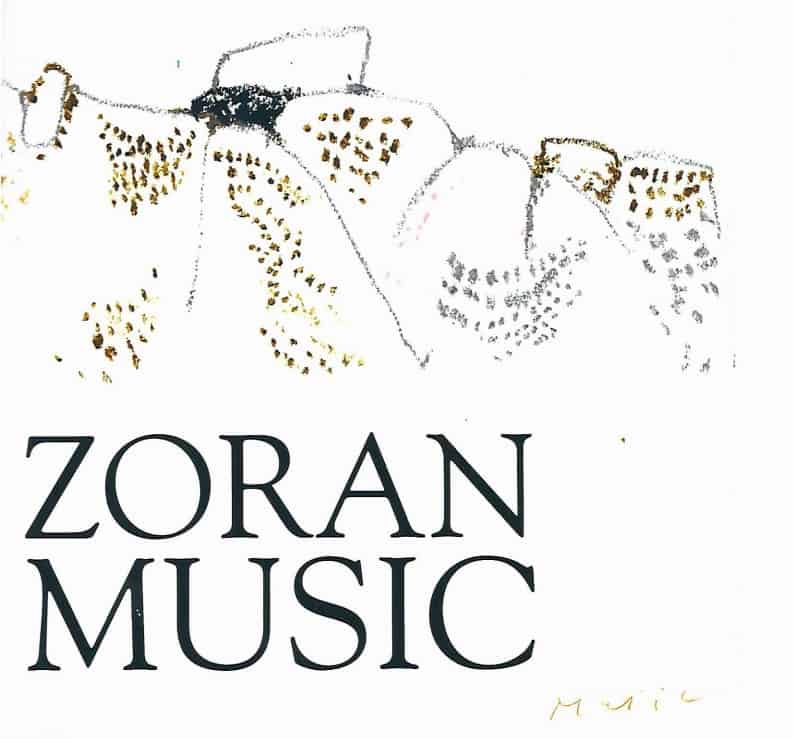
€ 98,–
(plus stroški dostave)
Pošljite svoje kontaktne podatke za naročanje knjige v galerijo Magnet:
Po prejetju naročila vam bo knjiga poslala Galerie Magnet!
